文章目录
一、前言
本文基于spring-boot-2.2.14.BUILD-SNAPSHOT源码分析prepareContext准备应用上下文这一步骤。
二、prepareContext
承接上文,本文继续SpringApplication的run方法往下分析,看prepareContext这行代码

请求参数:
| 参数类型 | 参数简要说明 |
|---|---|
| ConfigurableApplicationContext context | createApplicationContext()方法的返回值,代表应用上下文 |
| ConfigurableEnvironment environment | 系统的环境变量信息的接口类 |
| SpringApplicationRunListeners listeners | SpringApplicationRunListener的集合类 |
| ApplicationArguments applicationArguments | 应用参数 |
| Banner printedBanner | 打印的Banner信息 |
进入方法实现:
private void prepareContext(ConfigurableApplicationContext context, ConfigurableEnvironment environment,
SpringApplicationRunListeners listeners, ApplicationArguments applicationArguments, Banner printedBanner) {
// 1、设置环境对象
//统一ApplicationContext和Application,使用Application的environment
context.setEnvironment(environment);
// 2、注册组件 设置ApplicationContext的beanNameGenerator、resourceLoader、
postProcessApplicationContext(context);
// 3、应用初始化器对ApplicationContext进行初始化处理(Initializers在构造SpringApplication时就从spring.factories中加载到了)
applyInitializers(context);
// 4、发布ApplicationContext准备妥当事件
listeners.contextPrepared(context);
// 5、打印startup日志信息
if (this.logStartupInfo) {
logStartupInfo(context.getParent() == null);
logStartupProfileInfo(context);
}
// 6 、添加特定的单例beans到 beanFactory中
// Add boot specific singleton beans
ConfigurableListableBeanFactory beanFactory = context.getBeanFactory();
beanFactory.registerSingleton("springApplicationArguments", applicationArguments);
if (printedBanner != null) {
beanFactory.registerSingleton("springBootBanner", printedBanner);
}
if (beanFactory instanceof DefaultListableBeanFactory) {
((DefaultListableBeanFactory) beanFactory)
.setAllowBeanDefinitionOverriding(this.allowBeanDefinitionOverriding);
}
if (this.lazyInitialization) {
context.addBeanFactoryPostProcessor(new LazyInitializationBeanFactoryPostProcessor());
}
// Load the sources加载资源
Set<Object> sources = getAllSources();
Assert.notEmpty(sources, "Sources must not be empty");
// 加载启动类,见启动类注入容器中
load(context, sources.toArray(new Object[0]));
// 触发contextLoaded事件
listeners.contextLoaded(context);
}
准备应用上下文环境AnnotationConfigServletWebServerApplicationContext, 执行了以下8个步骤
- 统一ApplicationContext和Application使用的environment
- 后置处理ApplicationContext
- 执行Initializers
- 发布contextPrepared事件
- 打印启动和profile日志
- 注册单例bean
- 加载启动类
- 发布contextLoaded事件
2.1、context.setEnvironment
统一ApplicationContext和Application使用的environment
public class AnnotationConfigServletWebServerApplicationContext
extends ServletWebServerApplicationContext implements AnnotationConfigRegistry {
@Override
public void setEnvironment(ConfigurableEnvironment environment) {
//显式调用父类AbstractApplicationContext的setEnvironment方法
super.setEnvironment(environment);
//调用AnnotatedBeanDefinitionReader#setEnvironment()方法
this.reader.setEnvironment(environment);
//ClassPathBeanDefinitionScanner继承了ClassPathScanningCandidateComponentProvider,所以调用了父类setEnvironment方法
this.scanner.setEnvironment(environment);
}
}
将context中相关的environment全部替换成SpringApplication中创建的environment。还记得《SpringBoot源码分析(5)–createApplicationContext创建应用上下文》中的疑问吗,引申下就是:之前我们的应用中有两个environment,一个在context中,一个在SpringApplication中。经过此方法后,就只会存在SpringApplication中的environment了,而context中的原environment会被回收。
关于这点我们上篇有提到过一个瑕疵,因为这里虽然替换了容器原生的environement,但之前初始化SpringBootExceptionReporter的时候,已经把原生的environment设置到了异常分析器中,这些分析器持有的environment没有得到同步的更新,并不是我们真正使用的环境对象。
2.2、postProcessApplicationContext(context);
执行了以下三步
- 设置ApplicationContext的beanNameGenerator
- 设置ApplicationContext的resourceLoader和classLoader
- 设置ApplicationContext的类型转换Service
protected void postProcessApplicationContext(ConfigurableApplicationContext context) {
//beanNameGenerator默认为null,所以此处没有设置
if (this.beanNameGenerator != null) {
//如果beanNameGenerator不为空
//那么注册一个名为internalConfigurationBeanNameGenerator
//值为beanNameGenerator的单例bean
context.getBeanFactory().registerSingleton(
AnnotationConfigUtils.CONFIGURATION_BEAN_NAME_GENERATOR,
this.beanNameGenerator);
}
//resourceLoader默认为null,所以此处没有设置
if (this.resourceLoader != null) {
//如果resourceLoader不为空
if (context instanceof GenericApplicationContext) {
//context是GenericApplicationContext子类
//那么设置上下文context的resourceLoader
((GenericApplicationContext) context)
.setResourceLoader(this.resourceLoader);
}
if (context instanceof DefaultResourceLoader) {
//如果当前上下文是DefaultResourceLoader的子类
//那么设置上下文context的classLoader
((DefaultResourceLoader) context)
.setClassLoader(this.resourceLoader.getClassLoader());
}
}
//this.addConversionService默认为true
if (this.addConversionService) {
//设置类型转换Service
context.getBeanFactory().setConversionService(
ApplicationConversionService.getSharedInstance());
}
}
首先看SpringApplication对象中有没有自定义的BeanNameGenerator,有的话就注册到容器的单例池,这个对象是用来给容器中的Bean生成名字的,Spring容器new出来的时候会默认生成一个,默认的命名策略就是类名小写,不过SpringApplication中的该对象默认是null的
然后看SpringApplication对象有没有自定义ResourceLoader,有的话就赋值给容器,这个我们之前也分析过,默认也是null的
最后一个if分支,addConversionService在SpringApplication对象的构造函数里就默认设置为true,所以会走if,它为容器设置了一个ConversonService,这个类是用来做类型转换的,比如String转Integer等等,其实在之前的文章中已经见过几次了
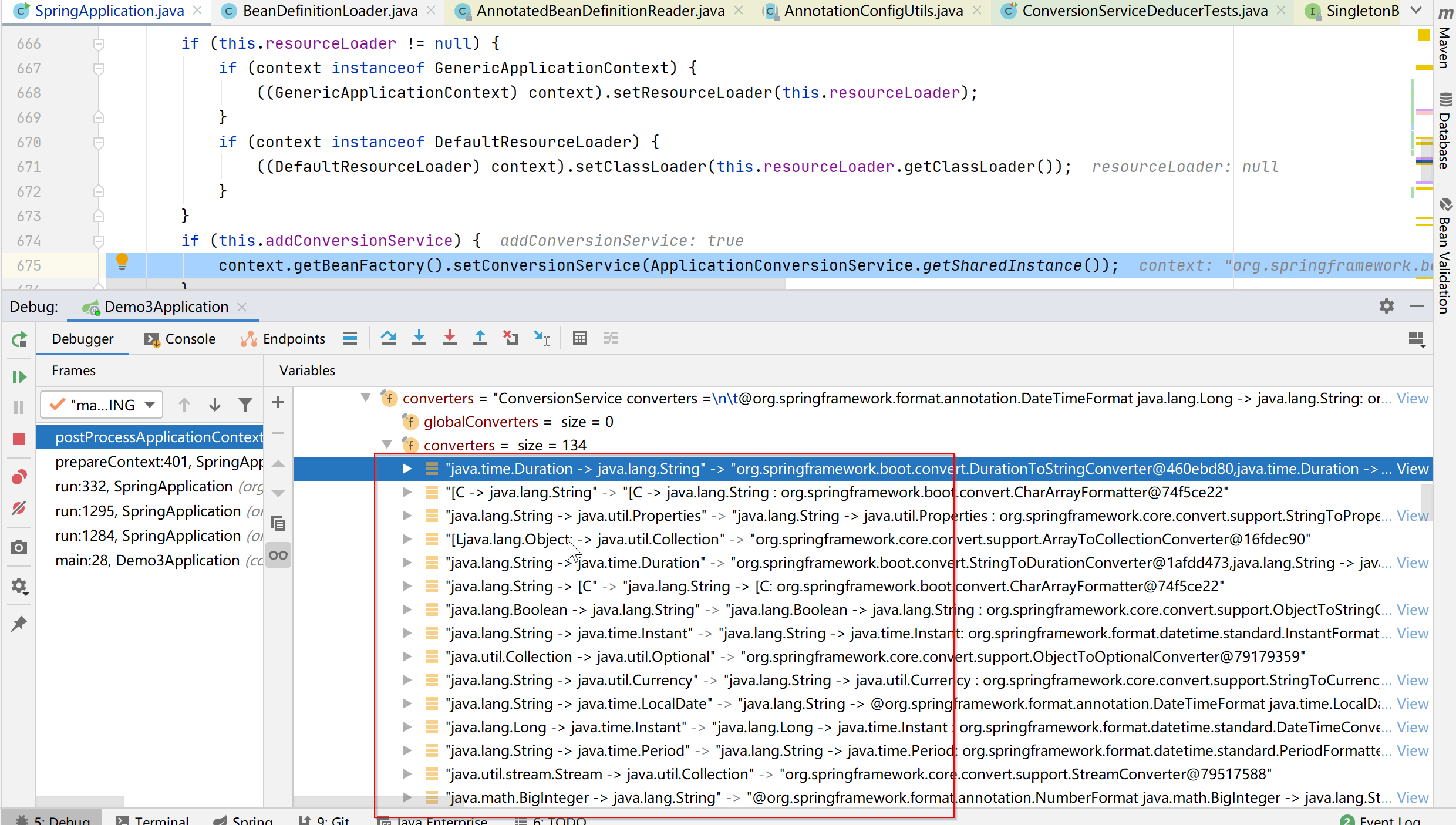
2.3、applyInitializers(context)
加载的是META-INF/spring.factories中的ApplicationContextInitializer列表 ,并依次调用其initialize方法
protected void applyInitializers(ConfigurableApplicationContext context) {
for (ApplicationContextInitializer initializer : getInitializers()) {
//断言判断initializer的类型是否符合条件
Class<?> requiredType = GenericTypeResolver.resolveTypeArgument(initializer.getClass(),
ApplicationContextInitializer.class);
Assert.isInstanceOf(requiredType, context, "Unable to call initializer.");
//执行各个initializer的初始化initialize方法
initializer.initialize(context);
}
}
initializers在SpringApplication初始化期间获取到,获取源码可参考《SpringBoot源码分析(2)–SpringBoot启动源码(万字图文源码debug讲解springboot启动原理)》, 一共获取到7个初始化器:
- DelegatingApplicationContextInitializer
- SharedMetadataReaderFactoryContextInitializer
- ContextIdApplicationContextInitializer
- ConfigurationWarningsApplicationContextInitializer
- ServerPortInfoApplicationContextInitializer
- ConditionEvaluationReportLoggingListener
- RSocketPortInfoApplicationContextInitializer
本文先梳理prepareContext方法的脉络,至于这些内置的ApplicationContextInitializer做了哪些初始化,我们下篇文章《SpringBoot源码分析(8)–内置ApplicationContextInitializer》单独分析
所有的这些初始化类都没有进行启动服务的实质性操作,都是通过注册对象,埋点,后面invokeBeanFactoryPostProcessors才真正调用初始化方法,而且在项目启动之前
2.4、发布ApplicationContextInitializedEvent事件
// 4、发布ApplicationContext准备妥当事件
listeners.contextPrepared(context);
Application容器初始化完成事件, 对该事件感兴趣的监听器有
- BackgroundPreinitializer
- DelegatingApplicationListener
BackgroundPreinitializer
扩展点, 后台进程初始化器, 用于多线程执行后台耗时任务, 在这里不处理ApplicationContextInitializedEvent事件
DelegatingApplicationListener
扩展点, 代理监听器, 继续分发事件, 不处理ApplicationContextInitializedEvent事件
2.5、打印启动和profile日志
//logStartupInfo默认为true
if (this.logStartupInfo) {
//判断是否有父容器,打印项目启动信息
// Starting Demo3Application on pcname with PID 12372 (E:\workspace\demo3\target\classes started by username in E:\workspace\demo3)
logStartupInfo(context.getParent() == null);
//打印profile
//No active profile set, falling back to default profiles: default
logStartupProfileInfo(context);
}
这段代码判断当前容器是否有父容器,如果没有的话就认为是项目启动的根容器,会打印一行日志,包括启动类、当前的服务器名、项目路径、PID等
2023-07-18 10:35:07.105 INFO 3136 --- [ main] com.example.demo.Demo3Application : Starting Demo3Application on hualsd with PID 3136 (D:\WorkSpace\demo3\target\classes started by 188 in D:\WorkSpace\demo3)
2023-07-18 10:35:32.693 INFO 3136 --- [ main] com.example.demo.Demo3Application : The following profiles are active: sit
2.6、注册单例Bean
注册了两个单例Bean
- 命令行参数bean, 名称为springApplicationArguments, 值为applicationArgument
- banner bean, 名称为springBootBanner, 值为printedBanner
//注册命令行参数bean
beanFactory.registerSingleton("springApplicationArguments", applicationArguments);
if (printedBanner != null) {
//banner bean
beanFactory.registerSingleton("springBootBanner", printedBanner);
}
最终registerSingleton方法会把他们注册到singletonObjects容器中,从名字我们就可以看出来,这是个存放单例对象的容器。
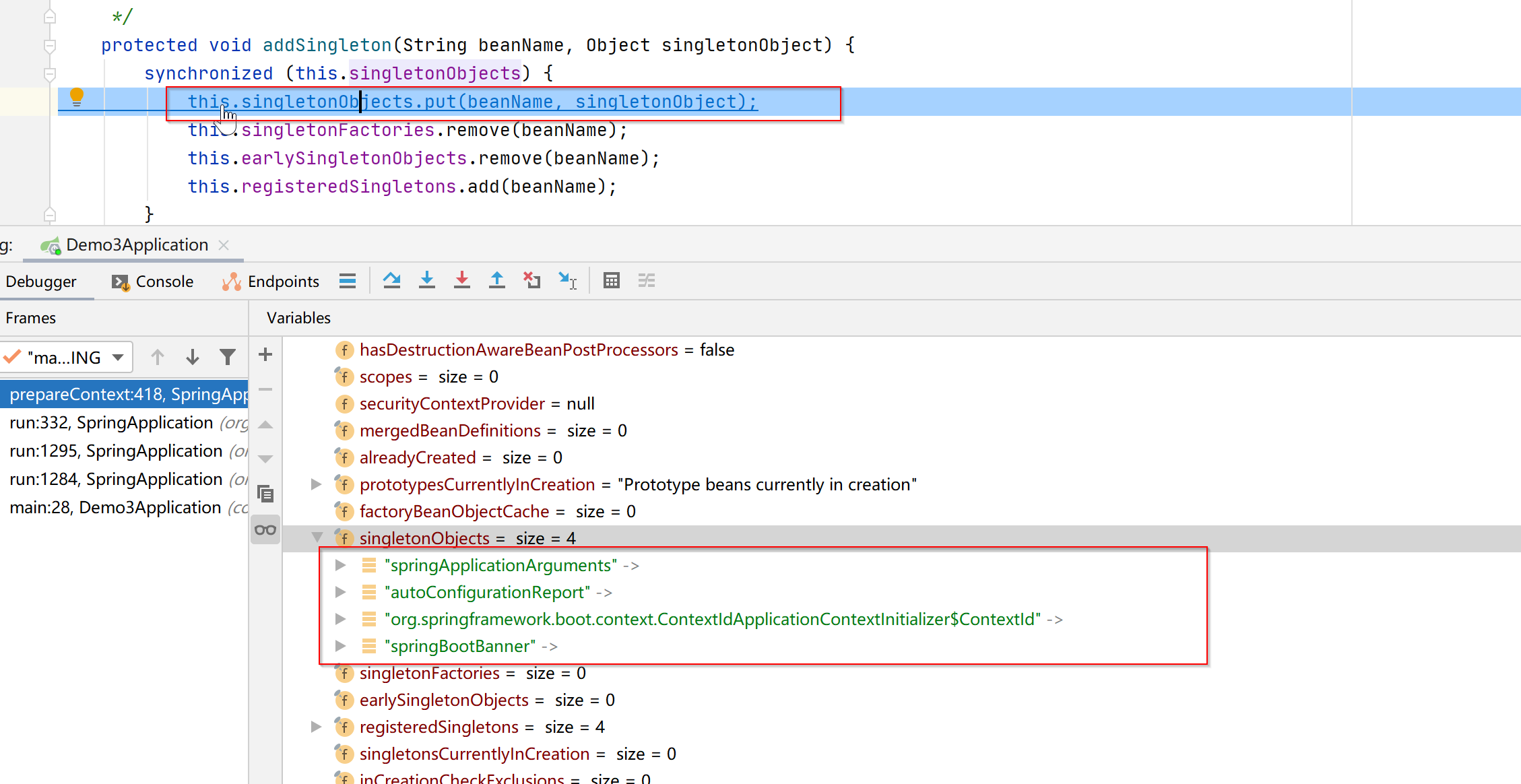
2.6.1、手工注册单例Bean流程
调用DefaultListableBeanFactory#registerSingleton方法, 显示调用父类DefaultSingletonBeanRegistry#registerSingleton方法
DefaultListableBeanFactory 手工注册单例Bean
手工注册单例Bean, 不同于扫描bean定义, 然后注册单例bean, 手工注册的单例Bean, 没有维护到beanDefinitionMap中, 而是将beanName维护到manualSingletonNames中
public class DefaultListableBeanFactory extends AbstractAutowireCapableBeanFactory
implements ConfigurableListableBeanFactory, BeanDefinitionRegistry, Serializable {
//注册单例bean
public void registerSingleton(String beanName, Object singletonObject) throws IllegalStateException {
super.registerSingleton(beanName, singletonObject);
//判断bean的创建过程是否已经开始了
//调用抽象父类AbstractBeanFactory#hasBeanCreationStarted()方法
//判断AbstractBeanFactory成员变量alreadyCreated Set不为空
if (hasBeanCreationStarted()) {
//bean创建过程已经开始了
//锁住成员变量beanDefinitionMap
synchronized (this.beanDefinitionMap) {
if (!this.beanDefinitionMap.containsKey(beanName)) {
//如果bean定义Map, beanDefinitionMap已经包含了bean
//维护到手工单例bean名称manualSingletonNames中
Set<String> updatedSingletons = new LinkedHashSet<>(this.manualSingletonNames.size() + 1);
updatedSingletons.addAll(this.manualSingletonNames);
updatedSingletons.add(beanName);
this.manualSingletonNames = updatedSingletons;
}
}
}
else {
// bean还没有注册过, 仍处于启动注册阶段
if (!this.beanDefinitionMap.containsKey(beanName)) {
//如果beanDefinitionMap不包含beanName
//那么添加到manualSingletonNames
this.manualSingletonNames.add(beanName);
}
}
//清空allBeanNamesByType和singletonBeanNamesByType
clearByTypeCache();
}
}
DefaultSingletonBeanRegistry手工注册单例Bean
将beanName添加到registeredSingletons中, beanName和对应的对象保存singletonObjects中, 并删除beanName对应的beanFactory, earlySingleton
//默认单例bean注册器
public class DefaultSingletonBeanRegistry extends SimpleAliasRegistry implements SingletonBeanRegistry {
//缓存单例bean, key为bean名称,value为bean实例
private final Map<String, Object> singletonObjects = new ConcurrentHashMap<>(256);
//缓存beanFactory, key为bean名称, value为beanFactory
private final Map<String, ObjectFactory<?>> singletonFactories = new HashMap<>(16);
//早期单例缓存, key为bean名称, value为bean实例
//为了解决循环依赖而引入的
private final Map<String, Object> earlySingletonObjects = new HashMap<>(16);
//单例bean名称set
private final Set<String> registeredSingletons = new LinkedHashSet<>(256);
//正在创建的单例bean名称set
private final Set<String> singletonsCurrentlyInCreation =
Collections.newSetFromMap(new ConcurrentHashMap<>(16));
//手工注册单例bean
@Override
public void registerSingleton(String beanName, Object singletonObject) throws IllegalStateException {
//判断名称和值不可以为空
Assert.notNull(beanName, "Bean name must not be null");
Assert.notNull(singletonObject, "Singleton object must not be null");
synchronized (this.singletonObjects) {
//判断bean是否为空
Object oldObject = this.singletonObjects.get(beanName);
if (oldObject != null) {
//不为空抛异常
throw new IllegalStateException("Could not register object [" + singletonObject +
"] under bean name '" + beanName + "': there is already object [" + oldObject + "] bound");
}
//添加一个单例bean
addSingleton(beanName, singletonObject);
}
}
//添加一个单例bean
protected void addSingleton(String beanName, Object singletonObject) {
synchronized (this.singletonObjects) {
//保存到singletonObjects的map中
this.singletonObjects.put(beanName, singletonObject);
this.singletonFactories.remove(beanName);
this.earlySingletonObjects.remove(beanName);
//添加beanName
this.registeredSingletons.add(beanName);
}
}
}
接着注册单例bean继续往下分析。
设置是否允许同名覆盖(setAllowBeanDefinitionOverriding),默认情况下为false(allowBeanDefinitionOverriding属性默认值)。如果为true,后面的BeanDefinition数据会将前面的覆盖掉。
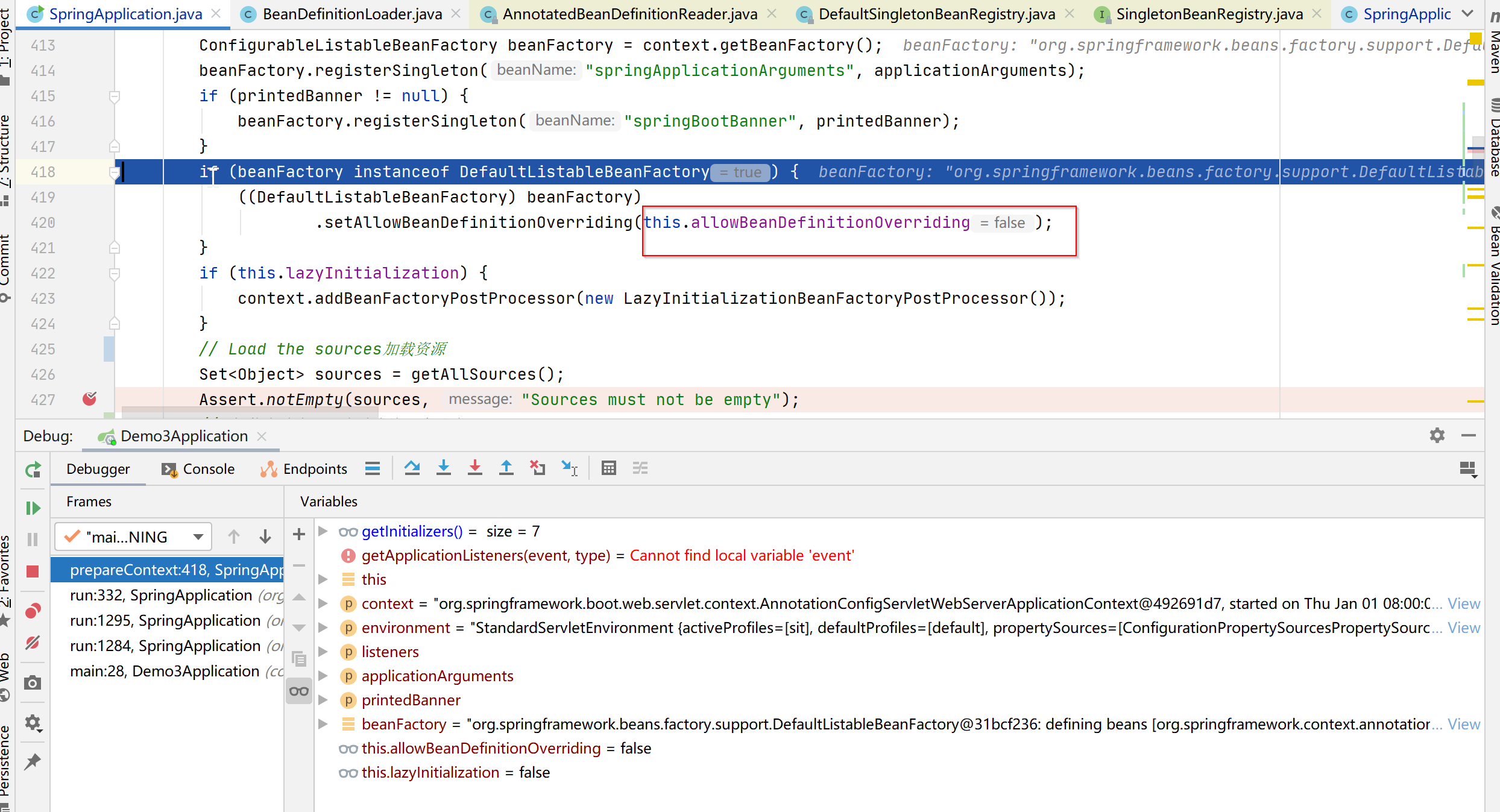
添加beanFactory懒加载后置处理器(addBeanFactoryPostProcessor),由于默认情况下并未启动懒加载,所以默认情况下懒加载后置处理器也不会被添加
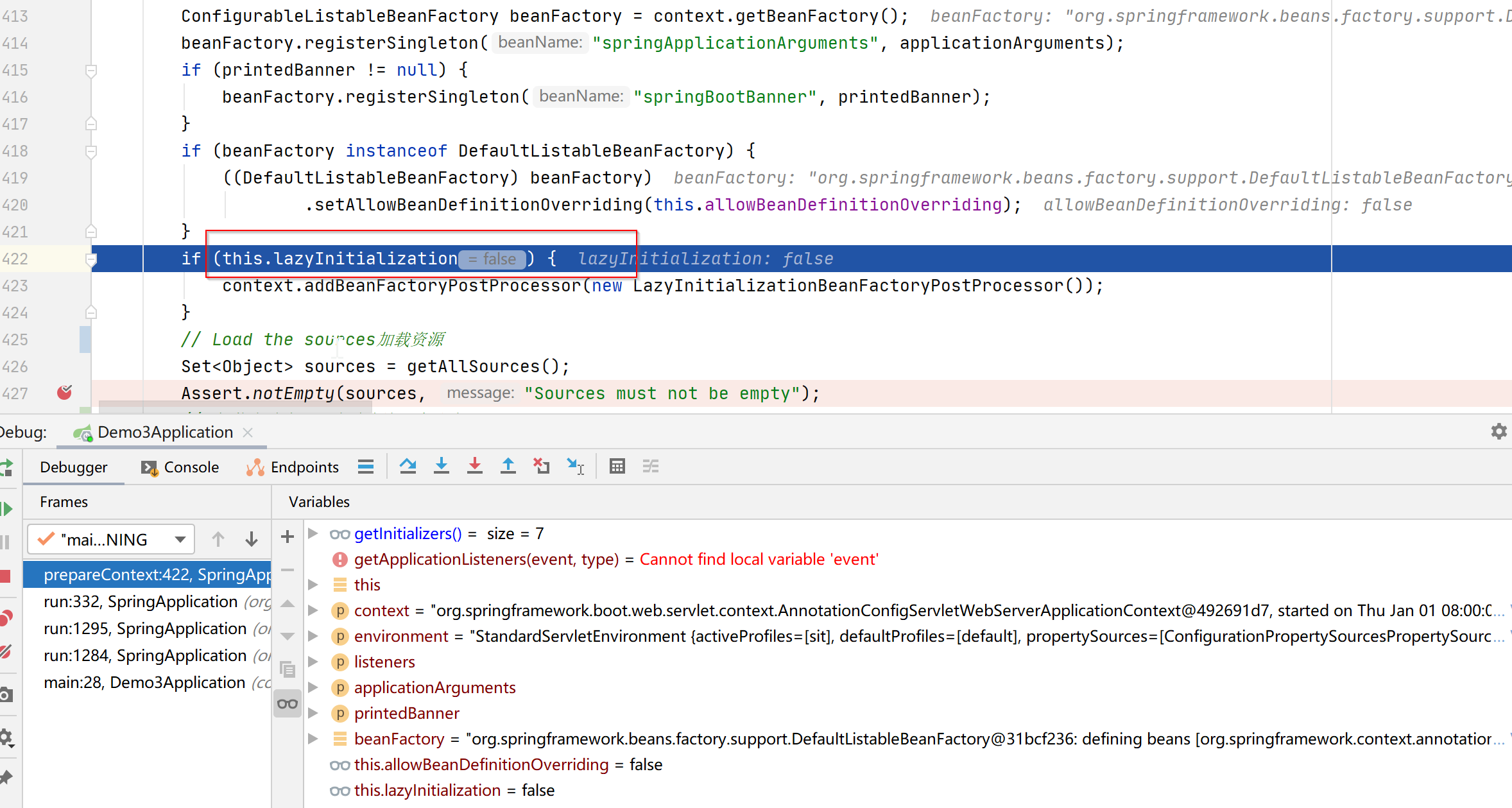
2.7、初始化BeanDefinitionLoader, 加载Application
接下来看一个比较重要的load方法
Set<Object> sources = this.getAllSources();
Assert.notEmpty(sources, "Sources must not be empty");
this.load(context, sources.toArray(new Object[0]));
getAllSources获取的是SpringApplication对象的primarySources属性,而该属性在SpringApplication构造函数中赋了值,也就是我们的启动类Demo3Application.class
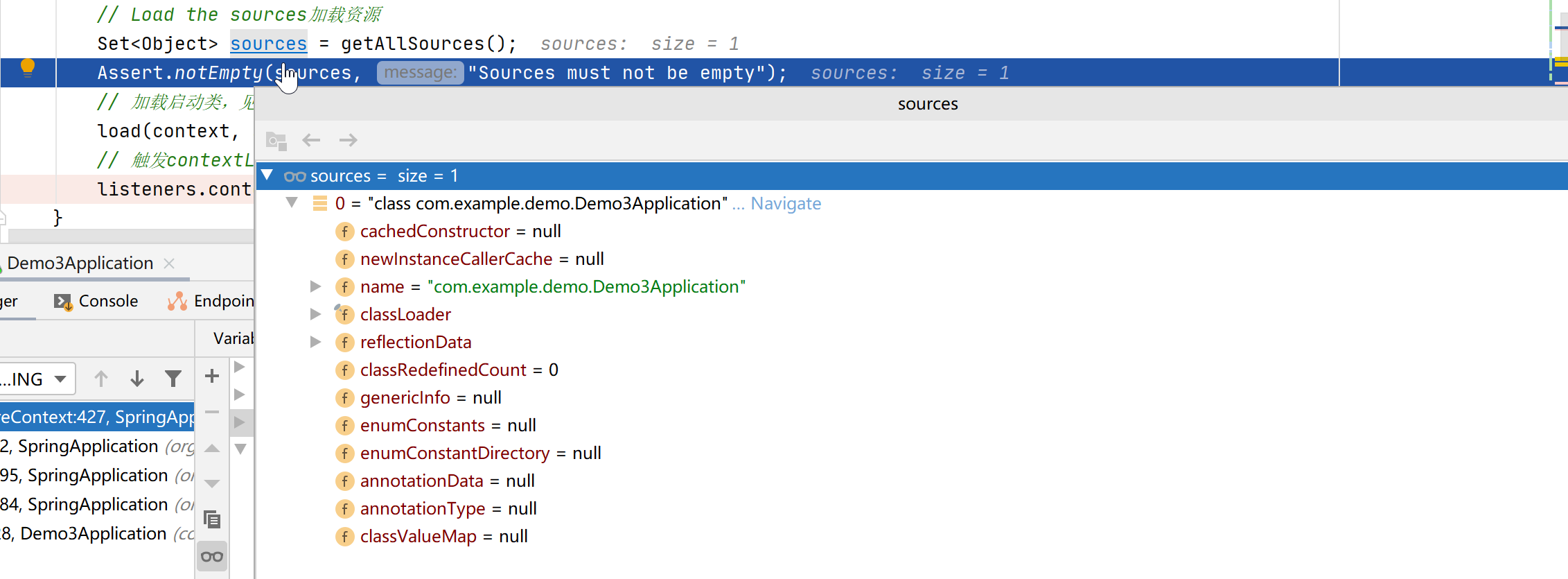
接下来进入load方法
protected void load(ApplicationContext context, Object[] sources) {
if (logger.isDebugEnabled()) {
logger.debug(
"Loading source " + StringUtils.arrayToCommaDelimitedString(sources));
}
//实例化BeanDefinitionLoader
BeanDefinitionLoader loader = createBeanDefinitionLoader(
getBeanDefinitionRegistry(context), sources);
//this.beanNameGenerator为null
if (this.beanNameGenerator != null) {
loader.setBeanNameGenerator(this.beanNameGenerator);
}
//this.resourceLoader为null
if (this.resourceLoader != null) {
loader.setResourceLoader(this.resourceLoader);
}
//this.environment为null
if (this.environment != null) {
loader.setEnvironment(this.environment);
}
//调用load()方法,加载各个sources
loader.load();
}
首先生成一个BeanDefinitionLoader, 用于加载SpringApplication的成员变量sources, 当前sources列表中只有Demo3Application.class一个对象。
先通过createBeanDefinitionLoader方法创建一个BeanDefinitionLoader,它可以将一个类加载成BeanDefinition,第一个参数就是spring容器,第二个参数是我们的启动类。
BeanDefinitionLoader构造方法
/**
* 构造函数
*/
BeanDefinitionLoader(BeanDefinitionRegistry registry, Object... sources) {
Assert.notNull(registry, "Registry must not be null");
Assert.notEmpty(sources, "Sources must not be empty");
//传入的sources, 目前只有Demo3Application.class
this.sources = sources;
this.annotatedReader = new AnnotatedBeanDefinitionReader(registry);
this.xmlReader = new XmlBeanDefinitionReader(registry);
if (isGroovyPresent()) {
//使用了groovy
this.groovyReader = new GroovyBeanDefinitionReader(registry);
}
this.scanner = new ClassPathBeanDefinitionScanner(registry);
//排除sources扫描
this.scanner.addExcludeFilter(new ClassExcludeFilter(sources));
}
在BeanDefinitionLoader的构造方法中,会创建一个AnnotatedBeanDefinitionReader对象,这个类在spring容器的构造函数中已经创建过一次了,这里没有直接使用spring容器的,而是又新建了一个,会重复走一遍Reader的构造流程,但是其中往spring容器注册bean的方法执行前都做了判空的校验,所以不会重复注册,类似如下代码
if (!registry.containsBeanDefinition("org.springframework.context.annotation.internalAutowiredAnnotationProcessor")) {
def = new RootBeanDefinition(AutowiredAnnotationBeanPostProcessor.class);
def.setSource(source);
beanDefs.add(registerPostProcessor(registry, def, "org.springframework.context.annotation.internalAutowiredAnnotationProcessor"));
}
回到load方法,接下来几个if分支都不会进,默认情况下SpringApplication中的beanNameGenerator、resourceLoader、environment都是null,注意我们真正使用的environment是在SpringApplication对象的run方法中创建的,并没有赋值给它自己的environment变量,所以这里依然是null
进入最后一行load方法
/**
* 加载sources
*/
public int load() {
int count = 0;
for (Object source : this.sources) {
count += load(source);
}
return count;
}
正常情况下启动类只有一个,继续跟进load方法
//加载Object资源
private int load(Object source) {
Assert.notNull(source, "Source must not be null");
if (source instanceof Class<?>) {
//加载类资源
return load((Class<?>) source);
}
if (source instanceof Resource) {
//加载Resource资源
return load((Resource) source);
}
if (source instanceof Package) {
//加载Package资源
return load((Package) source);
}
if (source instanceof CharSequence) {
//加载字符串资源
return load((CharSequence) source);
}
throw new IllegalArgumentException("Invalid source type " + source.getClass());
}
我们启动类是class类型,走第一个分支
//加载类资源
private int load(Class<?> source) {
if (isGroovyPresent()
&& GroovyBeanDefinitionSource.class.isAssignableFrom(source)) {
// 使用了groovy,加载groovy资源
GroovyBeanDefinitionSource loader = BeanUtils.instantiateClass(source,
GroovyBeanDefinitionSource.class);
load(loader);
}
//如果有@Component注解
if (isComponent(source)) {
this.annotatedReader.register(source);
return 1;
}
return 0;
}
isComponent方法判断启动类上是否有@Component注解,启动类加了@SpringBootApplication注解,它是一个复合注解,内部包含了@Component注解,所以这个分支成立,进入register方法
public class AnnotatedBeanDefinitionReader {
//Class列表注册Bean定义
public void register(Class<?>... annotatedClasses) {
for (Class<?> annotatedClass : annotatedClasses) {
//单个Bean注册
registerBean(annotatedClass);
}
}
}
registerBean调用doRegisterBean
public class AnnotatedBeanDefinitionReader {
//单个Class注册bean
public void registerBean(Class<?> annotatedClass) {
doRegisterBean(annotatedClass, null, null, null);
}
}
最终将我们的启动类转化为BeanDefinition注册到spring容器的BeanDefinitionMap中,后续会以此为起点,开始扫描项目中的Controller、Service等等注册到容器中
//注册Bean定义
<T> void doRegisterBean(Class<T> annotatedClass, @Nullable Supplier<T> instanceSupplier, @Nullable String name,
@Nullable Class<? extends Annotation>[] qualifiers, BeanDefinitionCustomizer... definitionCustomizers) {
//生成注解BeanDefinition
AnnotatedGenericBeanDefinition abd = new AnnotatedGenericBeanDefinition(annotatedClass);
//判断是否符合@Conditional注解的条件
//不满足的话, 就不注册Bean
if (this.conditionEvaluator.shouldSkip(abd.getMetadata())) {
return;
}
//设置instanceSupplier, //AbstractAutowireCapableBeanFactory#createBeanInstance中调用了instanceSupplier.get()生成bean实例
abd.setInstanceSupplier(instanceSupplier);
//Scope元空间
ScopeMetadata scopeMetadata = this.scopeMetadataResolver.resolveScopeMetadata(abd);
abd.setScope(scopeMetadata.getScopeName());
//生成Bean名称
String beanName = (name != null ? name : this.beanNameGenerator.generateBeanName(abd, this.registry));
//处理Lazy, Primary, DependsOn, Role, Description注解
AnnotationConfigUtils.processCommonDefinitionAnnotations(abd);
if (qualifiers != null) {
for (Class<? extends Annotation> qualifier : qualifiers) {
if (Primary.class == qualifier) {
abd.setPrimary(true);
}
else if (Lazy.class == qualifier) {
abd.setLazyInit(true);
}
else {
abd.addQualifier(new AutowireCandidateQualifier(qualifier));
}
}
}
for (BeanDefinitionCustomizer customizer : definitionCustomizers) {
//beanDefinition定制器
customizer.customize(abd);
}
//bean定义容器
BeanDefinitionHolder definitionHolder = new BeanDefinitionHolder(abd, beanName);
//Scope代理模式处理
//ScopedProxyMode.DEFAULT和NO不需要代理处理
//INTERFACES使用JDK动态代理
//TARGET_CLASS使用CGLIB动态代理
definitionHolder = AnnotationConfigUtils.applyScopedProxyMode(scopeMetadata, definitionHolder, this.registry);
//注册Bean定义
BeanDefinitionReaderUtils.registerBeanDefinition(definitionHolder, this.registry);
}
执行完毕后,可以看到Spring容器的BeanDefinitionMap中,已经添加了我们的启动类,而前面几个类都是在new容器的时候,内部AnnotatedBeanDefinitionReader初始化的过程中注册到容器里的

2.8、发布contextLoaded事件
调用listeners.contextLoaded(context), 发布了一个ApplicationPreparedEvent事件。
跟之前的事件发布机制一样,最终调用了EventPublishingRunListener的contextLoaded方法
public void contextLoaded(ConfigurableApplicationContext context) {
for (ApplicationListener<?> listener : this.application.getListeners()) {
if (listener instanceof ApplicationContextAware) {
((ApplicationContextAware) listener).setApplicationContext(context);
}
context.addApplicationListener(listener);
}
this.initialMulticaster.multicastEvent(new ApplicationPreparedEvent(this.application, this.args, context));
}
这个for循环,遍历了SpringApplication对象所有的监听器,也就是最开始创建SpringApplication的时候,从META-INF/spring.factories中加载到的ApplicationListener,在循环中,判断Listener是否实现了ApplicationContextAware接口,如果是的话就把Spring容器赋给他
这个Aware的回调本来也是在Spring容器refresh的过程执行的,但是由于这里的监听器可能仅仅是存储在容器的一个列表属性里,而并不会注册到容器中,也就不会作为Bean管理起来,后续就没办法真正在spring容器的refresh过程以正常的方式触发回调,所以就在这里手动赋值了
然后在for循环的最后一个条件里,将其添加到spring容器的监听器列表,我们之前有提到过,容器启动后,事件发布的职能会转交给容器进行,而这里正是重要的一步,将内置的监听器列表交给了容器,有了监听器列表, 自然可以向它们广播事件了
最后发布事件ApplicationPreparedEvent,发布流程跟之前一样,最终感兴趣的监听器有四个:
- ConfigFileApplicationListener
- LoggingApplicationListener
- BackgroundPreinitializer
- DelegatingApplicationListener
2.8.1、ConfigFileApplicationListener
配置文件监听器
public class ConfigFileApplicationListener
implements EnvironmentPostProcessor, SmartApplicationListener, Ordered {
//事件处理
@Override
public void onApplicationEvent(ApplicationEvent event) {
if (event instanceof ApplicationEnvironmentPreparedEvent) {
onApplicationEnvironmentPreparedEvent(
(ApplicationEnvironmentPreparedEvent) event);
}
if (event instanceof ApplicationPreparedEvent) {
//处理ApplicationPreparedEvent
onApplicationPreparedEvent(event);
}
}
//处理ApplicationPreparedEvent
private void onApplicationPreparedEvent(ApplicationEvent event) {
this.logger.switchTo(ConfigFileApplicationListener.class);
addPostProcessors(((ApplicationPreparedEvent) event).getApplicationContext());
}
//applicationContext中添加一个PropertySourceOrderingPostProcessor
protected void addPostProcessors(ConfigurableApplicationContext context) {
//用于重排序PropertySourceOrderingPostProcessor
context.addBeanFactoryPostProcessor(
new PropertySourceOrderingPostProcessor(context));
}
}
2.8.2、LoggingApplicationListener
日志监听器
public class LoggingApplicationListener implements GenericApplicationListener {
private void onApplicationPreparedEvent(ApplicationPreparedEvent event) {
ConfigurableListableBeanFactory beanFactory = event.getApplicationContext()
.getBeanFactory();
//注册日志单例bean
if (!beanFactory.containsBean(LOGGING_SYSTEM_BEAN_NAME)) {
beanFactory.registerSingleton(LOGGING_SYSTEM_BEAN_NAME, this.loggingSystem);
}
}
}
2.8.3、BackgroundPreinitializer
后台预初始化器, 当前不做任务处理, 方便以后扩展
2.8.4、DelegatingApplicationListener
代理监听器, 不做任何处理, 方便以后扩展
三、总结
这一步的主要作用是为下面刷新applicationContext做准备
- 统一了ApplicationContext和Application的environment
- 设置ApplicationContext的beanNameGenerator,resouceLoader和classLoader, - 并设置beanFactory的类型转换Service
- 执行Initializer
- 发布ApplicationContextInitializedEvent
- 打印启动日志和profile日志
- 手工注册命令行和banner两个单例Bean
- 初始化BeanDefinitionLoader, 加载启动类sources
- 发布contextLoaded事件